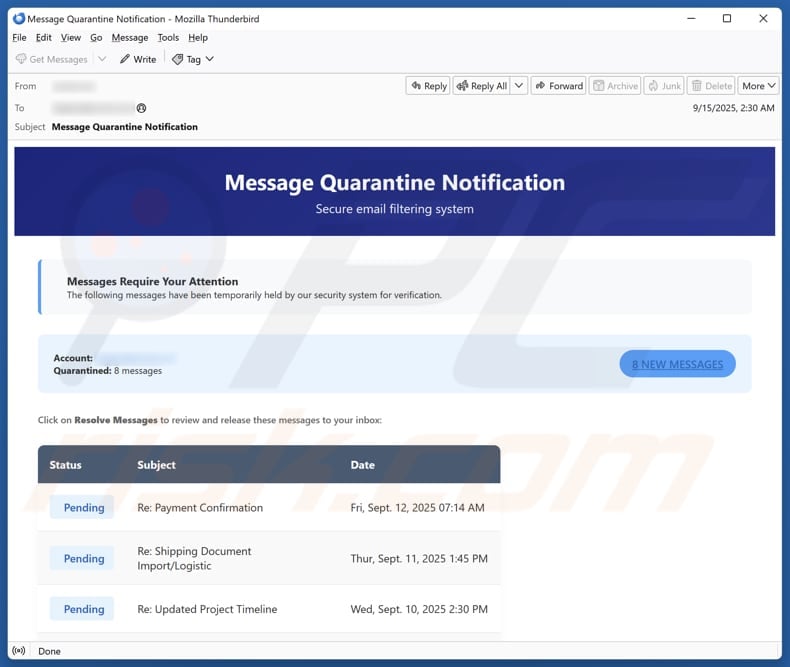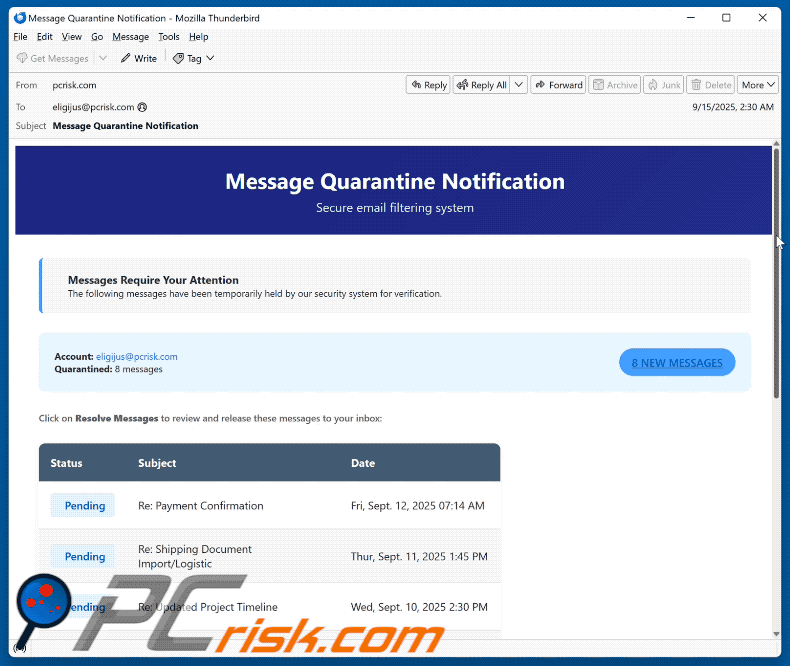How to identify scams like "Message Quarantine Notification"
Phishing/ScamAlso Known As: Message Quarantine Notification phishing email
Get free scan and check if your device is infected.
Remove it nowTo use full-featured product, you have to purchase a license for Combo Cleaner. Seven days free trial available. Combo Cleaner is owned and operated by RCS LT, the parent company of PCRisk.com.
What kind of scam is "Message Quarantine Notification"?
We have inspected the email and concluded that it is a phishing email disguised as a notification from an email service provider. Scammers use this scam to trick recipients into opening a fake website and entering personal information. Recipients should ignore this email to avoid account hijacking or other issues.

More about the "Message Quarantine Notification" scam email
This scam email pretends to be a notification from an email security system and claims that several messages have been quarantined for review. It lists multiple supposedly pending emails and urges the recipient to click a "Resolve Messages" button (link) to release them.
The message warns that the quarantine is due to suspicious links, unexpected senders, or potential phishing content. Its purpose is to trick recipients into clicking the link, which is supposed to open a phishing site (the page was not accessible during our inspection).
Usually, phishing pages included in such emails are designed to trick visitors into entering their email account login credentials so that scammers can access them. Hijacked email accounts can be exploited to gather personal information, send phishing emails, spread malware, and carry out other malicious activities.
Cybercriminals may also attempt to use stolen login details to access other accounts, such as social media, online banking, or gaming platforms. It is also important to mention that information obtained from compromised accounts is often sold to other criminals. Thus, it crucial to avoid interacting with suspicious emails.
| Name | Message Quarantine Notification Email Scam |
| Threat Type | Phishing, Scam, Social Engineering, Fraud |
| Fake Claim | Emails have been quarantined for review |
| Disguise | Notification from an email security system |
| Symptoms | Unauthorized online purchases, changed online account passwords, identity theft, illegal access of the computer. |
| Distribution methods | Deceptive emails, rogue online pop-up ads, search engine poisoning techniques, misspelled domains. |
| Damage | Loss of sensitive private information, monetary loss, identity theft. |
| Malware Removal (Windows) |
To eliminate possible malware infections, scan your computer with legitimate antivirus software. Our security researchers recommend using Combo Cleaner. Download Combo CleanerTo use full-featured product, you have to purchase a license for Combo Cleaner. 7 days free trial available. Combo Cleaner is owned and operated by RCS LT, the parent company of PCRisk.com. |
Similar scam emails in general
Scammers behind such emails often use pretend to be legitimate companies, services, or organizations to trick recipients into revealing personal information (or taking other actions). These emails often include deceptive links or harmful attachments. Engaging with such messages can result in stolen accounts, financial loss, identity theft, or other issues.
More examples of similar scams are "Request For Prices & Availability", "Email Address Verification Formal Notice", and "Mailbox Error Detected".
How do spam campaigns infect computers?
Threat actors often distribute malware via email attachments, which can include Word documents, Excel spreadsheets, PDFs, executables, ISO images, scripts, compressed files (such as ZIP and RAR), or other files. Opening these files or taking additional steps can lead to infection.
Malware can also be delivered through malicious links in emails. Clicking them may redirect users to compromised or fraudulent sites that either initiate automatic downloads or trick the user into installing malware.
How to avoid installation of malware?
Be cautious with unsolicited or irrelevant emails or messages - do not open attachments or click on suspicious links. Keep your operating system, browsers, and applications up to date, and download software or files only from official websites or trusted app stores.
Protect your device with reputable security software and run regular system scans. Additionally, avoid interacting with ads, links, or other elements on untrustworthy websites, and always decline notification requests from these pages.
Appearance of the "Message Quarantine Notification" scam email (GIF):

Text presented in the "Message Quarantine Notification" email letter:
Message Quarantine Notification
Secure email filtering system
Messages Require Your AttentionThe following messages have been temporarily held by our security system for verification.
Account: ********
Quarantined: 8 messages
8 NEW MESSAGESClick on Resolve Messages to review and release these messages to your inbox:
Status Subject Date
Pending Re: Payment Confirmation Fri, Sept. 12, 2025 07:14 AM
Pending Re: Shipping Document Import/Logistic Thur, Sept. 11, 2025 1:45 PM
Pending Re: Updated Project Timeline Wed, Sept. 10, 2025 2:30 PM
Pending AW: New Order Tue, Sept. 9, 2025 12:15 PM
Pending Request for Quotation Mon, Sept. 8, 2025 10:45 AM
RESOLVE MESSAGES (8)
Why were these messages quarantined?Our security system may hold messages for various reasons including suspicious links, unexpected senders, or content that matches common phishing patterns. This helps protect your account from potential threats.
This is an automated message from your email security system. Please do not reply to this message.
If you have any questions, please contact your system administrator.
This message was sent securely from your email filtering systemThis email was sent to ********.
Unsubscribe from quarantine notifications | Security Settings
Instant automatic malware removal:
Manual threat removal might be a lengthy and complicated process that requires advanced IT skills. Combo Cleaner is a professional automatic malware removal tool that is recommended to get rid of malware. Download it by clicking the button below:
DOWNLOAD Combo CleanerBy downloading any software listed on this website you agree to our Privacy Policy and Terms of Use. To use full-featured product, you have to purchase a license for Combo Cleaner. 7 days free trial available. Combo Cleaner is owned and operated by RCS LT, the parent company of PCRisk.com.
Quick menu:
- What is Message Quarantine Notification phishing email?
- Types of malicious emails.
- How to spot a malicious email?
- What to do if you fell for an email scam?
Types of malicious emails:
![]() Phishing Emails
Phishing Emails
Most commonly, cybercriminals use deceptive emails to trick Internet users into giving away their sensitive private information, for example, login information for various online services, email accounts, or online banking information.
Such attacks are called phishing. In a phishing attack, cybercriminals usually send an email message with some popular service logo (for example, Microsoft, DHL, Amazon, Netflix), create urgency (wrong shipping address, expired password, etc.), and place a link which they hope their potential victims will click on.
After clicking the link presented in such email message, victims are redirected to a fake website that looks identical or extremely similar to the original one. Victims are then asked to enter their password, credit card details, or some other information that gets stolen by cybercriminals.
![]() Emails with Malicious Attachments
Emails with Malicious Attachments
Another popular attack vector is email spam with malicious attachments that infect users' computers with malware. Malicious attachments usually carry trojans that are capable of stealing passwords, banking information, and other sensitive information.
In such attacks, cybercriminals' main goal is to trick their potential victims into opening an infected email attachment. To achieve this goal, email messages usually talk about recently received invoices, faxes, or voice messages.
If a potential victim falls for the lure and opens the attachment, their computers get infected, and cybercriminals can collect a lot of sensitive information.
While it's a more complicated method to steal personal information (spam filters and antivirus programs usually detect such attempts), if successful, cybercriminals can get a much wider array of data and can collect information for a long period of time.
![]() Sextortion Emails
Sextortion Emails
This is a type of phishing. In this case, users receive an email claiming that a cybercriminal could access the webcam of the potential victim and has a video recording of one's masturbation.
To get rid of the video, victims are asked to pay a ransom (usually using Bitcoin or another cryptocurrency). Nevertheless, all of these claims are false - users who receive such emails should ignore and delete them.
How to spot a malicious email?
While cyber criminals try to make their lure emails look trustworthy, here are some things that you should look for when trying to spot a phishing email:
- Check the sender's ("from") email address: Hover your mouse over the "from" address and check if it's legitimate. For example, if you received an email from Microsoft, be sure to check if the email address is @microsoft.com and not something suspicious like @m1crosoft.com, @microsfot.com, @account-security-noreply.com, etc.
- Check for generic greetings: If the greeting in the email is "Dear user", "Dear @youremail.com", "Dear valued customer", this should raise suspiciousness. Most commonly, companies call you by your name. Lack of this information could signal a phishing attempt.
- Check the links in the email: Hover your mouse over the link presented in the email, if the link that appears seems suspicious, don't click it. For example, if you received an email from Microsoft and the link in the email shows that it will go to firebasestorage.googleapis.com/v0... you shouldn't trust it. It's best not to click any links in the emails but to visit the company website that sent you the email in the first place.
- Don't blindly trust email attachments: Most commonly, legitimate companies will ask you to log in to their website and to view any documents there; if you received an email with an attachment, it's a good idea to scan it with an antivirus application. Infected email attachments are a common attack vector used by cybercriminals.
To minimise the risk of opening phishing and malicious emails we recommend using Combo Cleaner Antivirus for Windows.
Example of a spam email:

What to do if you fell for an email scam?
- If you clicked on a link in a phishing email and entered your password - be sure to change your password as soon as possible. Usually, cybercriminals collect stolen credentials and then sell them to other groups that use them for malicious purposes. If you change your password in a timely manner, there's a chance that criminals won't have enough time to do any damage.
- If you entered your credit card information - contact your bank as soon as possible and explain the situation. There's a good chance that you will need to cancel your compromised credit card and get a new one.
- If you see any signs of identity theft - you should immediately contact the Federal Trade Commission. This institution will collect information about your situation and create a personal recovery plan.
- If you opened a malicious attachment - your computer is probably infected, you should scan it with a reputable antivirus application. For this purpose, we recommend using Combo Cleaner Antivirus for Windows.
- Help other Internet users - report phishing emails to Anti-Phishing Working Group, FBI’s Internet Crime Complaint Center, National Fraud Information Center and U.S. Department of Justice.
Frequently Asked Questions (FAQ)
Why did I receive this email?
Scammers often send identical messages to a wide audience. The email addresses used are usually obtained from leaked databases, fake websites, or other sources.
I have provided my personal information when tricked by this email, what should I do?
If login credentials are compromised, account passwords should be changed immediately. If access to the account is unavailable, the account's support team should be contacted for assistance.
I have downloaded and opened a file attached to this email, is my computer infected?
If a user opens an executable file, the computer is at high risk of infection. However, opening a document file, such as a .pdf or .doc, generally does not trigger malware, so the system may stay unaffected.
I have read the email but didn't open the attachment, is my computer infected?
Opening an email is not dangerous. A system can become infected only if the user clicks on links within the message or opens attached files.
Will Combo Cleaner remove malware infections that were present in email attachment?
Yes, Combo Cleaner can detect and eliminate most known malware infections. Because advanced malware can hide deep within the system, running a full system scan is recommended.
Share:

Tomas Meskauskas
Expert security researcher, professional malware analyst
I am passionate about computer security and technology. I have an experience of over 10 years working in various companies related to computer technical issue solving and Internet security. I have been working as an author and editor for pcrisk.com since 2010. Follow me on Twitter and LinkedIn to stay informed about the latest online security threats.
PCrisk security portal is brought by a company RCS LT.
Joined forces of security researchers help educate computer users about the latest online security threats. More information about the company RCS LT.
Our malware removal guides are free. However, if you want to support us you can send us a donation.
DonatePCrisk security portal is brought by a company RCS LT.
Joined forces of security researchers help educate computer users about the latest online security threats. More information about the company RCS LT.
Our malware removal guides are free. However, if you want to support us you can send us a donation.
Donate
▼ Show Discussion